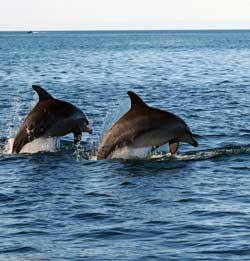Dolphins cultivate loose alliances

Two male dolphins in Shark Bay.<br>The Dolphin Alliance Project<br>
Male dolphins in Shark Bay, Australia, display the most complex group behavior of all mammals after us humans. Studies in the 1990s revealed that two to three male dolphins cooperate very closely with each other to isolate female dolphins from the main group for mating.
Sometimes, these so-called “first-order” alliances join forces to steal females that have been monopolized by other alliances. To a degree, however, this higher-level bond among males is highly opportunistic and can change depending on the context. The formation of alliances in dolphins is only comparable with that of humans in terms of complexity.
A new study by researchers from the USA, Australia and Michael Krützen from the University of Zurich’s Anthropological Institute & Museum now proves that these male alliances are based on an open social structure. Dolphins have multifaceted relationships with other individuals within a complex network without an obvious group structure, placing them almost on a par with us humans.
This begs a comparison with the social structure of chimpanzees. Chimpanzee males also form alliances, but only between social groups, which enables them to defend their territory against members of the same species from other groups. However, this is not the case with dolphins: They defend the females, not territories.
Another explanatory model would be that dolphin males only defend females or territories during the mating season and thus avoid each other as far as possible. However, this hypothesis does not apply to dolphins in Shark Bay, either, as the observation of over 120 adult dolphins in an area of around 600 square kilometers revealed. “Our study shows for the first time that the social structure and associated behavior of dolphins is unique in the animal kingdom,” explains Krützen.
Group behavior and the social structure of other species have always fascinated biologists. Are they similar to ours and, if yes, can we learn something about ourselves from them? The comparison of humans with apes, elephants and dolphins, all of which are species with large brains and highly developed cognitive skills, enable conclusions regarding the evolution of group behavior in humans to be drawn.
Literature:
Sradan Randic, Richard C. Connor, William B. Sherwin and Michael Krützen. A novel mammalian social structure in Indo-Pacific bottlenose dolphins: complex male-alliances in an open social network. In: Proceedings of the Royal Society. Doi: 10.1098/rspb.2012.0264
Contact:
Michael Krützen
Anthropological Institute & Museum
University of Zurich
Tel.: +41 44 635 54 12
Email: michael.kruetzen@aim.uzh.ch
Media Contact
More Information:
http://www.uzh.chAll latest news from the category: Life Sciences and Chemistry
Articles and reports from the Life Sciences and chemistry area deal with applied and basic research into modern biology, chemistry and human medicine.
Valuable information can be found on a range of life sciences fields including bacteriology, biochemistry, bionics, bioinformatics, biophysics, biotechnology, genetics, geobotany, human biology, marine biology, microbiology, molecular biology, cellular biology, zoology, bioinorganic chemistry, microchemistry and environmental chemistry.
Newest articles

“Nanostitches” enable lighter and tougher composite materials
In research that may lead to next-generation airplanes and spacecraft, MIT engineers used carbon nanotubes to prevent cracking in multilayered composites. To save on fuel and reduce aircraft emissions, engineers…

Trash to treasure
Researchers turn metal waste into catalyst for hydrogen. Scientists have found a way to transform metal waste into a highly efficient catalyst to make hydrogen from water, a discovery that…

Real-time detection of infectious disease viruses
… by searching for molecular fingerprinting. A research team consisting of Professor Kyoung-Duck Park and Taeyoung Moon and Huitae Joo, PhD candidates, from the Department of Physics at Pohang University…





















